Since I relocated my office, my commute to work has been cut down from a 5 minute walk up Richmond Street down to a 1 minute walk across the street. House door to office door takes 1:15. Here’s a short video to illustrate.
My comm
One of the unexpected benefits of taking up residence in the St. Paul’s Parish Hall basement is getting to know more about the parish that’s been our neighbour for the 17 years we’ve lived across the street.
Archdeacon John Clarke, who leads the parish, maintains a blog, and I’ve been an enthusiastic reader of it for the last few months. More often than not I find useful insight in what he writes, even if I need to translate into my decidedly more secular frame of reference.
In today’s post, he describes his upcoming sabbatical:
I could have taken all sorts of courses and studied lots of subjects that would have added nothing useful to my ministry or my sermons. Instead, I will try and learn how to play the guitar. It too may prove to be useless or futile, but I remain hopeful. I may never haul out the guitar in public or you may come to dread seeing me pick it up during a sermon.
By way of reassuring parishioners concerned about his absence, he adds:
So, to the point of what will be different, my hope is that you’ll will hardly know I’m gone. As one person put it, “the parish got along just fine for 235 years before you, we can do 3 months easily.”
I am proud to be an ex officio member of the parish community, a parish led by someone with good humour and the courage to take on a new challenge like this.
When I stepped out of the shower this morning I was overcome by a sudden realization that my only job–my only job–for the two or three hours to follow was to stay calm. This realization proved very helpful, both because staying calm is always helpful, and because it made me realize that there was little else for me to do. “Accept and release,” as Catherine always says.
Oliver needed to have blood drawn this morning, part of a regular diagnostic test. Although he’s made strides in overcoming his adversity to needles in recent years, it remains a challenging thing to confront for him, so he did not greet this prospect warmly.
If we’ve learned anything about the health system as parents it’s that often tremendous help is waiting if you remember to ask; to this end, in advance of the blood test, I contacted the pediatric clinic at the Queen Elizabeth Hospital for advice, and they put us in touch with a fantastic person, Shira Zipursky, their “child life specialist,” who became a sort of specimen-collecting-concierge and spirit-guide for us.
Last night Oliver and I purchased some “numbing cream,” which Shira suggested as a way of mitigating the pain of the needle (and perhaps, in addition, numbing the prospect of the pain of the needle); we ran a beta test before bed, and it all worked out well, so when Oliver got up this morning the first thing we did was to apply the cream, along with air-tight dressing, to three sites on his right arm (hand, elbow crease, shoulder). By the time we arrived at the hospital, the cream was in full effect, and numbing was happening.
Oliver, to his enormous credit, held things together really well as we arrived at the hospital; he knew he was nervous, and we knew he was nervous, but he maintained control.
Shira met us at admitting, greeted Oliver by name, ushered us to the admitting desk, and made sure everything was in order. Once Oliver was admitted, she suggested that, rather than going into the crowded waiting room, we hang about in the lobby, which was helpful, as Oliver, empathetic as he is, sponges up the anxiety of others, and one can only imagine that a Specimen Collection waiting room held a lot of it.
Just as things seemed to be rolling along smoothly, “Code Purple, Specimen Collection” came over the public address system, and a shard of tension sliced through the air as concerned-looking security staff and others converged on the room we were about to enter, and “pause” was pressed on our progress (the Internet is inconclusive on what a Code Purple is: options range from hostage situation to gang activity).
Fortunately, Oliver was oblivious to this, as the skillful Shira had brought along an iPad loaded with all manner of fun video games and he and Catherine were engrossed in one involving trains and police officers and jumping.
After just a few minutes it seemed like the Code Purple dimmed and things returned to normal; the head of the Specimen Collection department came out to fetch us, and ushered us into a room where a couple of additional staff were primed and ready.
To say that things went smoothly from there would be an overstatement, as Oliver, self-contained until this point, was overtaken by a flood of anxiety, and we all–himself included–had to work really hard to calm him down. All of the Strongest Families tools in our toolbox got put to use: belly breathing, muscle relaxation, shoulder rolling, positive self-talk. The staff were patient, helpful, and didn’t rush things along (which would have made things worse). And they knew enough to know when Oliver’s stress had subsided just enough to allow them to make their move.
The blood draw went quickly, Oliver remained as calm as he could, and before we knew it everything was over.
I almost exploded in tears of joy at this point, as of course I’d been stressed out too, despite my goal of remaining calm, and there’s nothing like seeing your child under duress to tear at the very fabric of your soul, especially when it’s because of events you orchestrated.
We gathered ourselves together, thanked everyone, and headed out to a well-deserved breakfast at Receiver Coffee before dropping Oliver at school.
We owe Shira and her specimen-collecting colleagues at the Queen Elizabeth Hospital a great debt of gratitude for making what could have been a dreadful, negative experience into one that, while still stressful, was well-managed, safe for all concerned, positive, and efficient. Thank you.
Earlier this month, Ton mused about whether it was time to return to the blogroll (and, yes, it may seem like recently my blog has turned into musing about Ton musing about things I’ve mused about; you can join in, though!).
One of the things I found when I was poking around inside Tiny Tiny RSS, which I use to consume RSS feeds, is that it provides a public URL for an OPML file that contains all of the feeds I subscribe to. So I’ve stuck that in the footer of this site (as “OPML (Blogroll)”) and you can grab it right now if you like.
Update: I switched to using FreshRSS as my RSS reader, and it only supports exporting my OPML, so I’ve manually uploaded it, and you can grab it here.
For the uninitiated, let me unpack this:
I read a bunch of websites.
These websites get updated, all on different schedules.
Some update every day. Some every hour. Some one every six months.
I don’t want to have to open up my web browser and type www.zylstra.org every morning on the off chance that Ton has written something: I want a robot to do that for me.
That’s what RSS is all about: I give my RSS reader a list of websites that have RSS feeds (a list of things that have been written, sorted by date, in a way that is easy for a robot to consume), and the RSS reader goes off, every 15 minutes, all on its own, and looks to see if there’s anything new. If there is, the new items show up in my RSS reader, where I read them.
An OPML file adds one more level of abstraction: an OPML file is a machine-readable list of RSS feeds themselves, a list that I can pass around to other people, sort of like a reading list or list of references. Ideally, they can import the OPML file into their RSS reader, and, presto!, they can subscribe to the same things I subscribe to.
Here’s what an OPML file look like under the hood:
<?xml version="1.0" encoding="utf-8"?>
<opml version="1.0">
<head>
<dateCreated>Thu, 26 Apr 2018 20:54:02 +0000</dateCreated>
<title>Tiny Tiny RSS Feed Export</title>
</head>
<body>
<outline text="Friends">
<outline type="rss" text="Edward Hasbrouck" xmlUrl="https://hasbrouck.org/blog/index.xml" htmlUrl="https://hasbrouck.org/blog/"/>
<outline type="rss" text="Elmine Wijnia" xmlUrl="http://storymin.es/feed/" htmlUrl="http://storymin.es"/>
<outline type="rss" text="Olle Jonsson" xmlUrl="http://ollehost.dk/blog/feed/" htmlUrl="http://ollehost.dk/blog"/>
<outline type="rss" text="Parker Higgins" xmlUrl="https://parkerhiggins.net/feed/" htmlUrl="https://parkerhiggins.net"/>
<outline type="rss" text="Peter Bihr" xmlUrl="http://www.thewavingcat.com/feed/rss/" htmlUrl="http://www.thewavingcat.com"/>
<outline type="rss" text="Steven Garrity" xmlUrl="http://www.actsofvolition.com/feed" htmlUrl="http://www.actsofvolition.com/"/>
<outline type="rss" text="Ton Zijlstra" xmlUrl="https://www.zylstra.org/blog/feed/" htmlUrl="https://www.zylstra.org/blog"/>
</outline>
</body>
</opml>
That’s just a slice of my OPML file, and it lists the RSS feeds of my friends.
Like RSS, OPML never really went away. But it feels good to be talking about it again, as, like RSS, it’s one of those very useful bits of plumbing that makes the social web work.
After supper this evening we found ourselves in need of three things: numbing cream (to assist with a blood test Oliver is having in the morning), a toilet flap, and exercise.
As the nearest source of toilet flaps was Home Hardware on St. Peters Road, we decided to combine all three missions into an epic walk, stopping at Parkdale Pharmacy along the way for the numbing cream.
It was a beautiful, bright, warm night for a walk. Almost all of the ice and snow are gone from the streets, and the ground is almost dry.
We walked down Richmond Street to Cumberland, along the short Routes for Nature and Health diversion in back of Maritime Electric, along the Confederation Trail to Kensington Road, past the Civic Center (where the Islanders are playing tonight) to Linden Drive, and down Linden to Parkdale Pharmacy.
The numbing cream at Parkdale Pharmacy turned out to be considerably cheaper than at Shoppers Drug Mart, so by this point the trip had already paid for itself.
From Parkdale Pharmacy we walked straight out St. Peters Road to Home Hardware. After some consultations with a helpful clerk about the complicated world of toilet flaps, we acquired what, in his estimate, was the most likely candidate.
We walked out of the back of the Home Hardware parking lot to MacKay Drive, a street I’m pretty sure I’d never been on before.
At the top of MacKay Drive we encountered a prominent Charlottetown lawyer who marveled that anyone from downtown had walked so far out into the suburbs. He also told us something of the futuristic bubble house down the street that we’d encountered on our way up the hill.
We cut down Vic Campbell Boulevard to avoid getting trapped in a Möbious loop of deepest Parkdale, turned right on Palmers Lane, dashed across Mount Edward Road, and made our way onto the Experimental Farm.
On top of the rise we found ourselves in the middle of Premiers Grove, filled with trees planted to memorialize Island premiers. We found the Robert Ghiz tree, the Keith Milligan tree, the Catherine Callbeck tree, and the Wade Maclauchlan tree.
We made our way through the Grove, around past the Lily Pond, and back down to the Confederation Trail.
We ducked through the Farm Centre Legacy Garden, past the bee huts, and out the other side by Upstreet Brewing.
We crossed Allen Street to Walthen Drive, walked down Walthen to Prince Street School, cut through the playground to Upper Prince Street, and walked down Prince Street to home.
The walk took us 90 minutes from start to finish, covered 6.44 kilometers and 7,709 steps.
We fully expect that for generations to come the residents of MacKay Drive will speak of the time those two fellows walked all the way out from town on a bright spring evening.
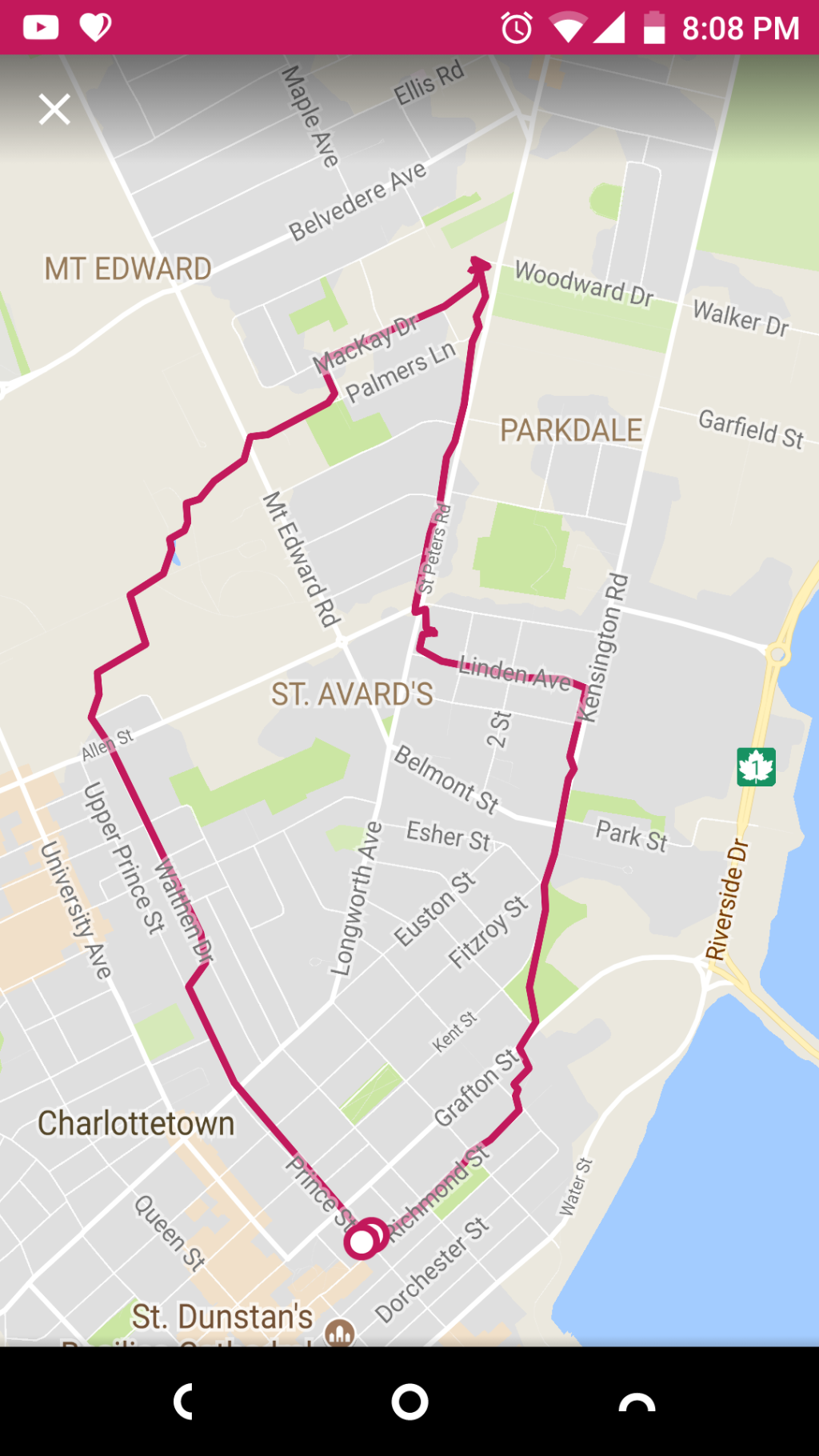 ,
, 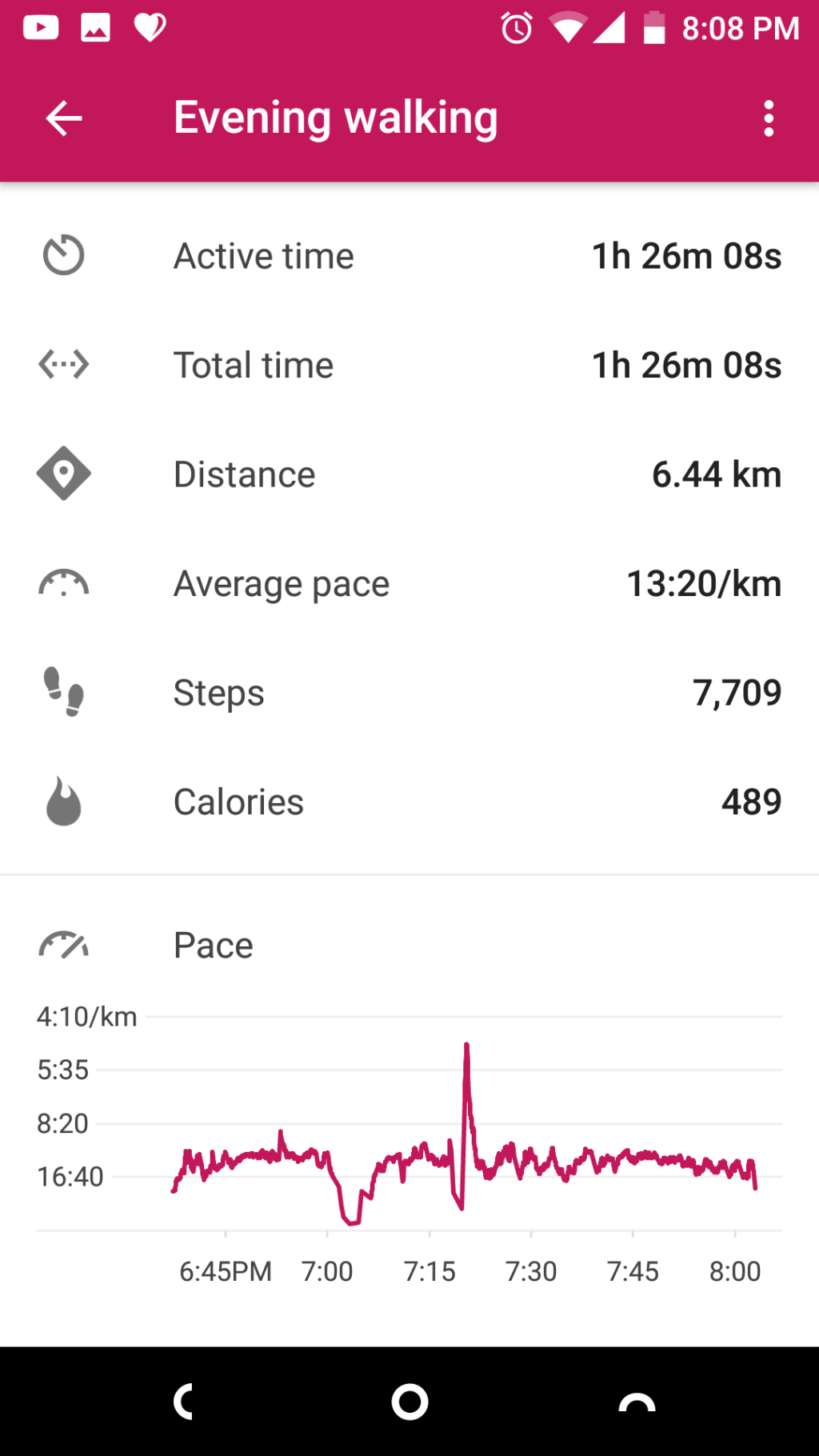
Ton muses about an RSS Revival:
RSS is the most important piece of internet plumbing for following new content from a wide range of sources. It allows you to download new updates from your favourite sites automatically and read them at your leisure. Dave Winer, forever dedicated to the open web, created it.
I used to be a very heavy RSS user. I tracked hundreds of sources on a daily basis. Not as news but as a way to stay informed about the activities and thoughts of people I was interested in. At some point, that stopped working. Popular RSS readers were discontinued, most notably Google’s RSS reader, many people migrated to the Facebook timeline, platforms like Twitter stopped providing RSS feeds to make you visit their platform, and many people stopped blogging. But with FB in the spotlight, there is some interest in refocusing on the open web, and with it on RSS.
I’ve been an emitter and consumer of RSS feeds since the very beginning, and so, for me, there’s no need for a revival, as I never left. I currently have 86 RSS feeds in my RSS reader, ranging from Ton’s blog itself to security alerts to CBC news headlines to the blogs of several Prince Edward Island MLAs:
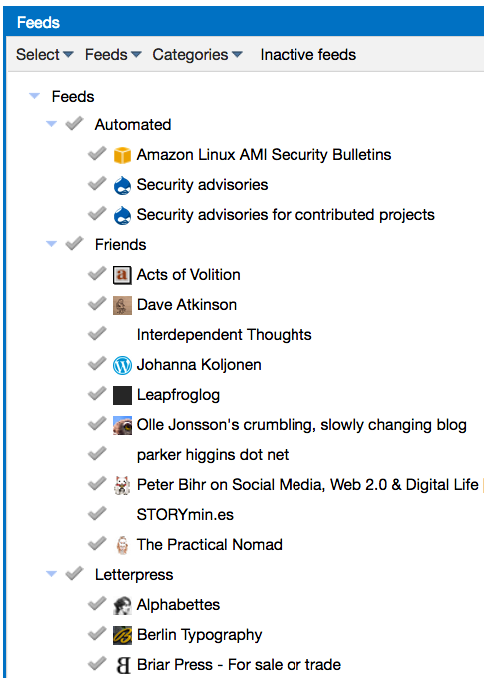
For the longest time, like many others, I consumed RSS feeds in Google Reader; when it was shut down by Google, I replaced this with a self-hosted instance of Tiny Tiny RSS, a serviceable replacement.
When I’m using my laptop, I read my RSS feeds in Tiny Tiny RSS’s web interface in a browser:
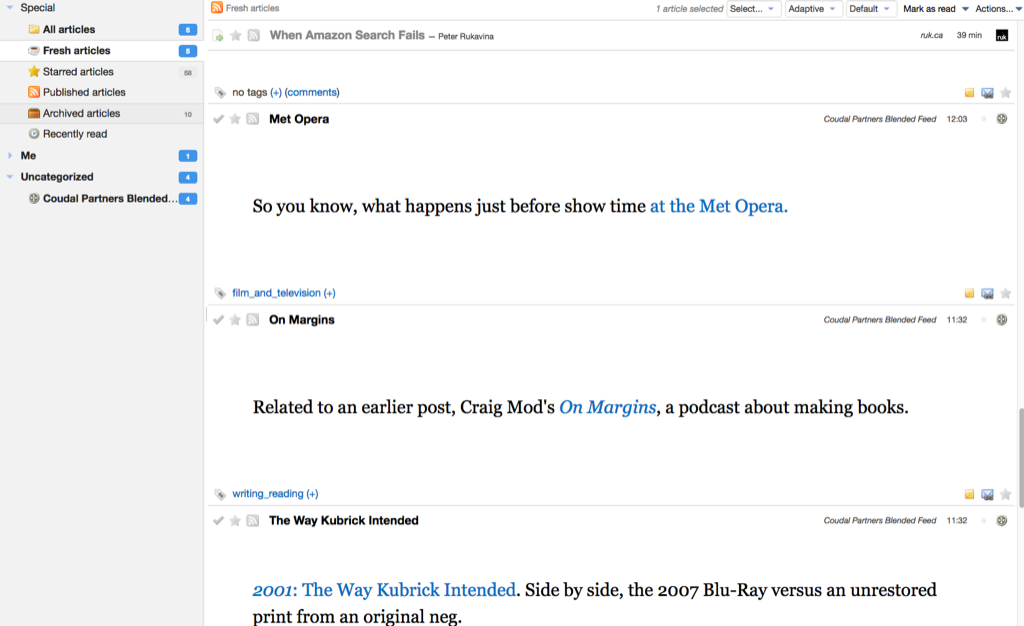
When I’m on my Android phone, I use the Tiny Tiny RSS app, which syncs itself with the server so that what I’ve read and what I haven’t is always current:
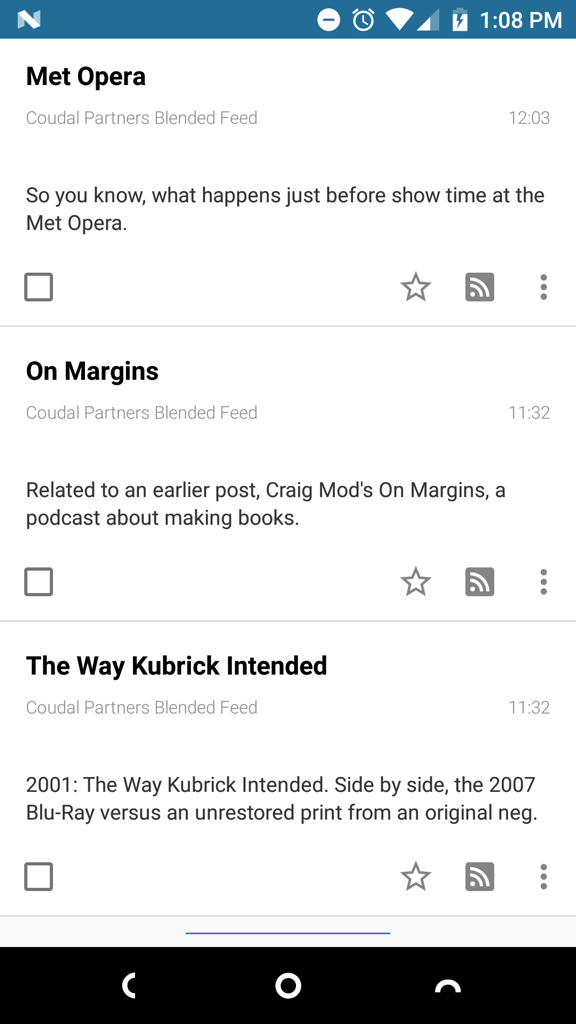
I self-host Tiny Tiny RSS, rather than using a third-party service like Feedly, because, well, once-bitten-twice-shy: I don’t want my RSS consumption to be dependent on the corporate whims of an RSS reader company. Besides, what’s the point of taking a collection of independent, decentralized feeds and centralizing them?
That said, I recognize that running a personal Tiny Tiny RSS server is outside the realm of possibility for most people. I also recognize that a lot of RSS nomenclature, including the name RSS itself, stands as a barrier to a lot of people. So there’s work to be done here to catalyze the revival that Ton writes about, a revival that, despite my own perseverance, I fully support and see the benefits of.
The ink is dry and I’m left with a pile of 75 freshly-printed envelopes, ready for use. I send more mail that the average person, so these won’t really last a lifetime. But they should take me through the year. Watch your mailboxes.
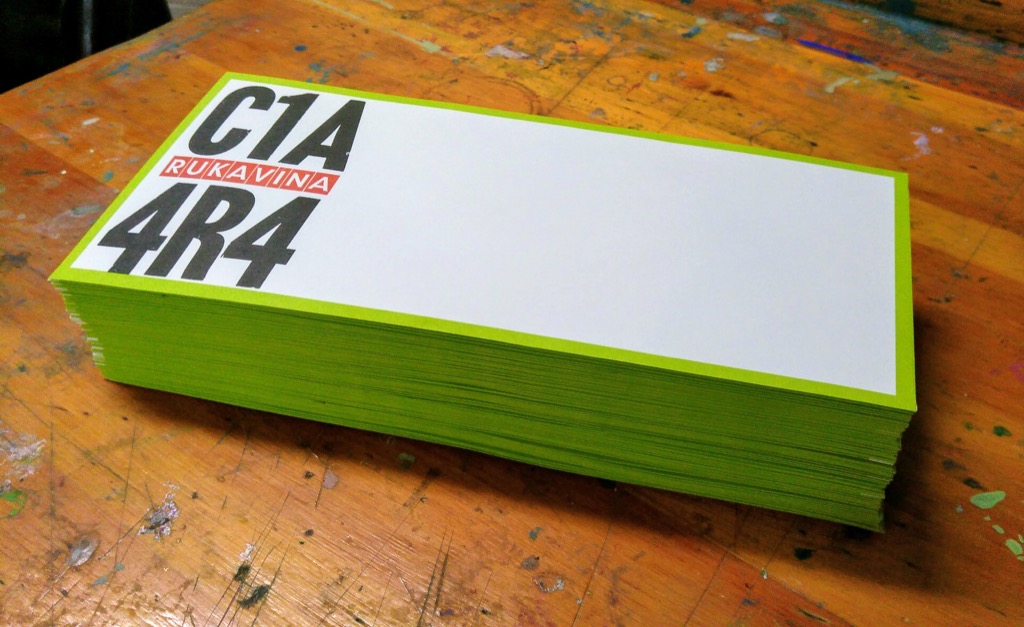
When Amazon search fails, it fails spectacularly: I was looking for the book, mentioned here, Bookbinding: The Complete Guide to Folding, Sewing & Binding. Amazon thought, absent that, I might be interested in a guide to folding knives. A complete guide.

Spotted recently: Instagram now supports downloading all of the data you’ve contributed to it since you opened your account. To use this tool, login to Instagram and navigate to the “Privacy and Security” setting and scroll down to “Data Download”:
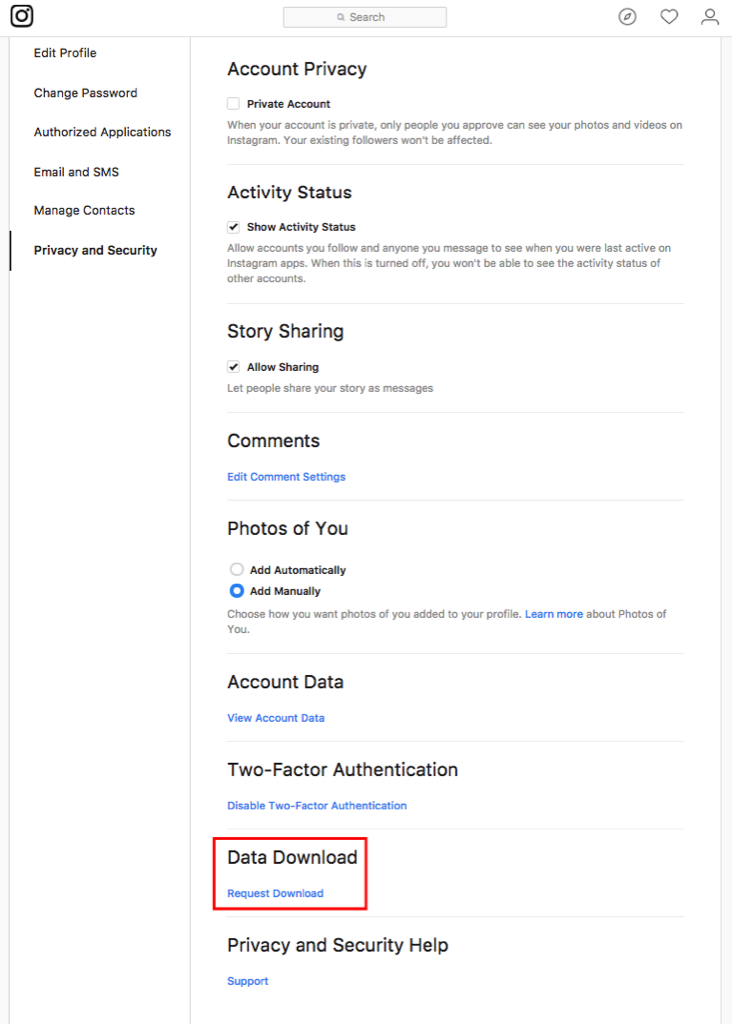
It takes a few minutes (at least in my case) to build the archive, and when it’s ready you get a only-works-for-four-days download link to grab a ZIP archive of all the images and videos you’ve uploaded, along with JSON representations of likes, messages and other metadata.
 I am
I am